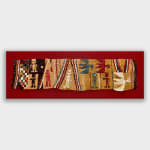




Sihuas Culture 500 BC-650 AD
20,2 x 57,6 cm (framed)
5'2" x 20'2" in
7'9" x 22'6" in (framed)
Further images
Pukara, a precolumbian culture which dates from 500 BC to 400 AD. Pukara is called the " MOTHER CULTURE OF THE ALTIPLANO". If we look at a part of history, it tells us that the Pukara culture led to the Tiahuanaco (present-day Bolivia) and Inca (Cusco) cultures.
The Pukara culture was responsible the domestication of the alpaca, an animal that, like the llama, not only supplied the settlements with meat, it also provided the main raw material for weavings. The quantity of remains found in the excavations give an idea of the importance of this type of livestock.
We know that the woven textiles had a very significant importance in the Pukara economy and were one of the most traded goods with other cultures.









